Trigonometry - Benjamin-Mills
Trigonometry - Benjamin-Mills
Trigonometry - Benjamin-Mills
You also want an ePaper? Increase the reach of your titles
YUMPU automatically turns print PDFs into web optimized ePapers that Google loves.
<strong>Trigonometry</strong><br />
What’s trigonometry?<br />
<strong>Trigonometry</strong> is a method for finding sides or angles in a right-angled triangle.<br />
It consists of three formulae that are used in three different situations.<br />
What you know What you want to find What you use<br />
two sides the third side Pythagoras’ theorem<br />
two sides an angle trigonometry<br />
one side and an angle another side trigonometry<br />
In a right-angled triangle, one of the angles is<br />
always 90°. You need to know another angle to<br />
use trigonometry.<br />
90 ! " !<br />
In fact, if you know one of the non-90° angles, you<br />
can calculate the other: you just subtract the angle<br />
you know from 90°.<br />
!<br />
Labelling your triangle<br />
In order to know which of the three formulae to use in a particular situation,<br />
you first need to label your triangle carefully. There are names and symbols<br />
for each of the three sides.<br />
The longest side (which also happens to be the side opposite the right angle)<br />
is called the hypotenuse. This name is also used in Pythagoras’ theorem.<br />
o<br />
h<br />
a<br />
!<br />
opposite<br />
angle<br />
hypotenuse<br />
adjacent<br />
side symbol definition<br />
longest side<br />
hypotenuse h side opposite the right angle<br />
opposite o side opposite angle θ<br />
adjacent a side next to angle θ that is not the hypotenuse
What’s ! ?<br />
The symbol θ is often used to represent an angle. This looks like a tablet or<br />
an egg sliced in half, but it is actually the Greek letter theta. Our alphabet<br />
(the Roman alphabet) has no letter equivalent to theta, but it is usually<br />
transliterated as th. In fact, the Pythagoras’ own name is spelt with a letter<br />
theta, since he was Greek: Πυθαγόρας.<br />
What are the formulae?<br />
When doing trigonometry, you always know two things and want to find a<br />
third, unknown thing. There are three formulae to choose from:<br />
sin! = o h<br />
cos! = a h<br />
tan! = o a<br />
A simple way to remember these rules is the mnemonic SOH CAH TOA,<br />
where S stand for sinθ, O stands for opposite and so on.<br />
It is important to understand that sinθ does not mean sin × θ as you would<br />
expect. It is actually a kind of number machine. You put in an angle between<br />
0° and 90° and you get out a number between 0 and 1.<br />
32 ! ! sine ! 0.5299<br />
This is normally written as<br />
sin32 ! = 0.5299<br />
How do I use trigonometry?<br />
You are given a triangle whose longest side is 10 cm. Another side is 7 cm<br />
long, and you need to find the angle between the two known sides.<br />
First of all, label your triangle:<br />
7 cm<br />
10 cm<br />
!<br />
labelling<br />
angle<br />
10 cm<br />
hypotenuse<br />
!<br />
7 cm<br />
adjacent
As you can see from the labelled triangle, h = 10 cm and a = 10 cm .<br />
You need the formula that contains h and a:<br />
cos! = a h<br />
If you substitute in the values for a and h given in the diagram, you get<br />
cos! = 7 cm<br />
10 cm<br />
therefore cos! = 0.7<br />
We need to find θ, not cosθ. The next step requires a calculator. You use the<br />
cos −1 button to convert cosθ to θ:<br />
cos! = 0.7 therefore ! = cos "1 ( 0.7) .<br />
In order to find θ, you have to use a calculator to find cos !1 ( 0.7) .<br />
Normally, you key in something like this: SHIFT cos 0 • 7 .<br />
When you press =, the result you get is the angle θ:<br />
cos !1 ( 0.7) = 45.572996 !<br />
You almost always round this value to the nearest decimal place or two.<br />
cos !1 ( 0.7) = 45.6 ! to 1 decimal place
Rearranging the formulae for different situations<br />
There are nine possible situations in which you can use trigonometry. Each<br />
one requires a formula to be rearranged in a slightly different way. The trick<br />
is to get the unknown quantity alone on one side of the equals sign, with<br />
everything else on the other side.<br />
All nine formulae shown are just rearrangements of the three main formulae<br />
we tend to refer to as SOHCAHTOA.<br />
o<br />
known<br />
h<br />
known<br />
!<br />
unknown<br />
a<br />
known<br />
h<br />
known<br />
!<br />
unknown<br />
o<br />
known<br />
a<br />
known<br />
!<br />
unknown<br />
# o&<br />
! = sin "1 $<br />
% h'<br />
(<br />
# a&<br />
! = cos "1 $<br />
% h'<br />
(<br />
# o&<br />
! = tan "1 $<br />
% a'<br />
(<br />
o<br />
unknown<br />
h<br />
known<br />
!<br />
known<br />
a<br />
unknown<br />
h<br />
known<br />
!<br />
known<br />
o<br />
known<br />
a<br />
unknown<br />
o = hsin! a = hcos! a = otan!<br />
!<br />
known<br />
o<br />
known<br />
h<br />
unknown<br />
!<br />
known<br />
a<br />
known<br />
h<br />
unknown<br />
!<br />
known<br />
o<br />
unknown<br />
a<br />
known<br />
!<br />
known<br />
h =<br />
o<br />
sin!<br />
h = a<br />
cos!<br />
o = a<br />
tan!


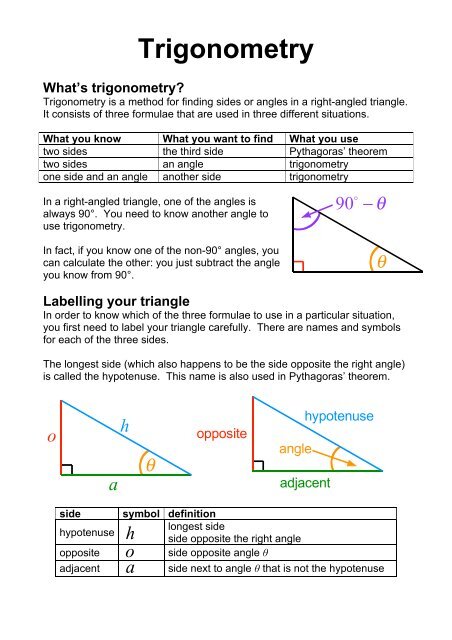
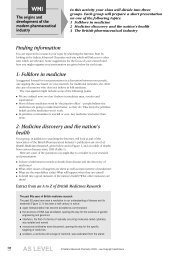
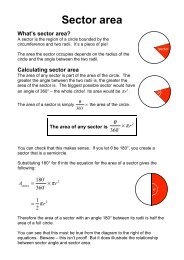
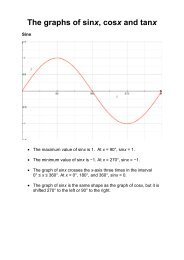


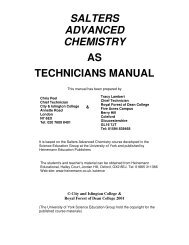



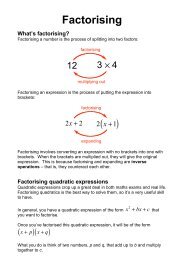
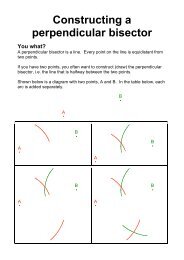

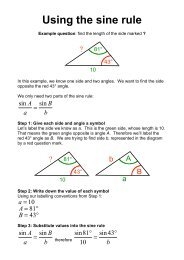
![ISI Web of Knowledge [v.4.10] - All Databases Results - Benjamin-Mills](https://img.yumpu.com/39253071/1/184x260/isi-web-of-knowledge-v410-all-databases-results-benjamin-mills.jpg?quality=85)